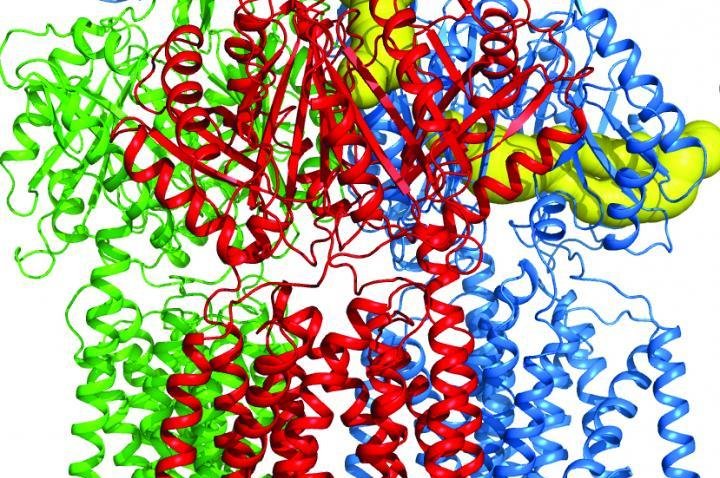
This is a ribbon diagram of the three-part efflux pump of the
Campylobacter jejuni bacterium. Researchers have identified how efflux
pumps and reinforced cell walls prevent antibiotics from working on
certain bacteria. Photo by Edward Yu/Iowa State University
Aug. 1 (UPI) -- Researchers at Iowa
State University have identified the structures and mechanisms that
allow bacteria to become resistant to antibiotics.
The study, published Aug. 1 in Nature Communications, described two structures and mechanisms, efflux pumps and reinforced cell walls, that disease-causing bacteria utilize to resist antibiotics.
"We study a lot of efflux pumps to understand antibiotic resistance," Edward Yu, an Iowa State professor in physics and astronomy, chemistry, biochemistry, biophysics and molecular biology, said in a press release. "Cell wall remodeling is also a major mechanism to work against antibacterial drugs. The structure and mechanism depend on the bacteria you're talking about -- and the bacteria will find a way."
Campylobacter jejuni bacterium causes digestive tract inflammation, or enterocolitis, and diarrhea uses a three-molecule efflux pump to avoid antibacterial drugs. The three molecules of the efflux pump work in a synchronized rotation creating three pumps in one structure.
In a second study published in the Proceedings of the National Academy of Sciences, the team describe how Burkholderia multivorans bacterium that causes pneumonia or cystic fibrosis remodel and strengthen its cell wall preventing the entry of antimicrobial drugs.
"Overall our data suggest a novel mechanism for hopanoid transport involved in cell wall remodeling, which is critical for mediating multidrug resistance in Burkholderia," the authors said.
The next step in the research process is to understand how to turn the pumps and transporters off to allow antibiotics to work.
The study, published Aug. 1 in Nature Communications, described two structures and mechanisms, efflux pumps and reinforced cell walls, that disease-causing bacteria utilize to resist antibiotics.
"We study a lot of efflux pumps to understand antibiotic resistance," Edward Yu, an Iowa State professor in physics and astronomy, chemistry, biochemistry, biophysics and molecular biology, said in a press release. "Cell wall remodeling is also a major mechanism to work against antibacterial drugs. The structure and mechanism depend on the bacteria you're talking about -- and the bacteria will find a way."
Campylobacter jejuni bacterium causes digestive tract inflammation, or enterocolitis, and diarrhea uses a three-molecule efflux pump to avoid antibacterial drugs. The three molecules of the efflux pump work in a synchronized rotation creating three pumps in one structure.
In a second study published in the Proceedings of the National Academy of Sciences, the team describe how Burkholderia multivorans bacterium that causes pneumonia or cystic fibrosis remodel and strengthen its cell wall preventing the entry of antimicrobial drugs.
"Overall our data suggest a novel mechanism for hopanoid transport involved in cell wall remodeling, which is critical for mediating multidrug resistance in Burkholderia," the authors said.
The next step in the research process is to understand how to turn the pumps and transporters off to allow antibiotics to work.
When News Breaks Out, We Break In. (The 2014 Bloggies Finalist)
No comments:
Post a Comment
Note: Only a member of this blog may post a comment.